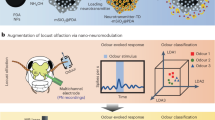Abstract
This paper presents a novel strategy for the response enhancement of olfactory sensory neurons (OSNs)-based biosensors by monitoring the enhancive responses of OSNs to odorants. An OSNs-based biosensor was developed on the basis of the light addressable potentiometric sensor (LAPS), in which rat OSNs were cultured on the surface of LAPS chip and served as sensing elements. LY294002, the specific inhibitor of phosphatidylinositol 3-kinase (PI3K), was used to enhance the responses of OSNs to odorants. The responses of OSNs to odorants with and without the treatment of LY294002 were recorded by LAPS. The results show that the enhancive effect of LY294002 was recorded efficiently by LAPS and the responses of this OSNs-LAPS hybrid biosensor were enhanced by LY294002 by about 1.5-fold. We conclude that this method can enhance the responses of OSNs-LAPS hybrid biosensors, which may provide a novel strategy for the bioelectrical signal monitor of OSNs in biosensors. It is also suggested that this strategy may be applicable to other kinds of OSNs-based biosensors for cellular activity detection, such as microelectrode array (MEA) and field effect transistor (FET).
Similar content being viewed by others
References
Ache, B.W., Young, J.M., 2005. Olfaction: diverse species, conserved principles. Neuron, 48(3):417–430. [doi:10.1016/j.neuron.2005.10.022]
Braet, F., Zanger, R.D., Wisse, E., 1997. Drying cells for SEM, AFM and TEM by hexamethyldisilazane: a study on hepatic endothelial cells. J. Microscopy, 186(1):84–87. [doi:10.1046/j.1365-2818.1997.1940755.x]
Buck, L., Axel, R., 1991. A novel multigene family may encode odorant receptors: a molecular basis for odor recognition. Cell, 65(1):175–187. [doi:10.1016/0092-8674(91)90418-X]
Hafeman, D.G., Parce, J.W., McConnell, H.M., 1988. Light-addressable potentiometric sensor for biochemical systems. Science, 240(4856):1182–1185. [doi:10.1126/science.3375810]
Huotari, M.J., 2000. Biosensing by insect olfactory receptor neurons. Sens. Actuators B: Chem., 71(3):212–222. [doi:10.1016/S0925-4005(00)00619-5]
Ismail, A.B., Yoshinobu, T., Iwasaki, H., Sugihara, H., Yukimasa, T., Hirata, I., Iwata, H., 2003. Investigation on light-addressable potentiometric sensor as a possible cell-semiconductor hybrid. Biosens. Bioelectron., 18(12):1509–1514. [doi:10.1016/S0956-5663(03)00129-5]
Lewcock, J.W., Reed, R.R., 2003. ORs rule the roost in the olfactory system. Science, 302(5653):2078–2079. [doi:10.1126/science.1093397]
Liu, Q.J., Cai, H., Xu, Y., Li, Y., Li, R., Wang, P., 2006. Olfactory cell-based biosensor: a first step towards a neurochip of bioelectronic nose. Biosens. Bioelectron., 22(2):318–322. [doi:10.1016/j.bios.2006.01.016]
Mori, K., Nagao, H., Yoshihara, Y., 1999. The olfactory bulb: coding and processing of odor molecule information. Science, 286(5440):711–715. [doi:10.1126/science.286.5440.711]
Ressler, K.J., Sullivan, S.L., Buck, L.B., 1994. Information coding in the olfactory system: evidence for a stereotyped and highly organized epitope map in the olfactory bulb. Cell, 79(7):1245–1255. [doi:10.1016/0092-8674(94)90015-9]
Schöning, M.J., Schroth, P., Schütz, S., 2000. The use of insect chemoreceptors for the assembly of biosensors based on semiconductor field-effect transistors. Electroanalysis, 12(9):645–652. [doi:10.1002/1521-4109(200005)12:9〈645::AID-ELAN645〉3.3.CO;2-F]
Schütz, S., Schoning, M.J., Schroth, P., Malkoc, Ü., Weißbecker, B., Kordos, P., Lüth, H., Hummel, H.E., 2000. An insect-based bioFET as a bioelectronic nose. Sens. Actuators B: Chem., 65(1–3):291–295. [doi:10.1016/S0925-4005(99)00325-1]
Spehr, M., Wetzel, C.H., Hatt, H., Ache, B.W., 2002. 3-Phosphoinositides modulate cyclic nucleotide signaling in olfactory receptor neurons. Neuron, 33(5):731–739. [doi:10.1016/S0896-6273(02)00610-4]
Stein, B., George, M., Gaub, H.E., Parak, W.J., 2004. Extracellular measurements of averaged ionic currents with the light-addressable potentiometric sensor (LAPS). Sens. Actuators B: Chem., 98(2–3):299–304. [doi:10.1016/j.snb.2003.10.034]
Vlahos, C.J., Matter, W.F., Hui, K.Y., Brown, R.F., 1994. A specific inhibitor of phosphatidylinositol 3-kinase, 2-(4-morpholinyl)-8-phenyl-4H-1-benzopyran-4-one (LY294002). J. Biol. Chem., 269:5241–5248.
Wu, C.S., Wang, L.J., Zhou, J., Zhao, L.H., Wang, P., 2007. The progress of olfactory transduction and biomimetic olfactory-based biosensors. Chin. Sci. Bull., 52(14):1886–1896. [doi:10.1007/s11434-007-0295-9]
Wu, C.S., Chen, P.H., Yu, H., Liu, Q.J., Zong, X.L., Cai, H., Wang, P., 2009. A novel biomimetic olfactory-based biosensor for single olfactory sensory neuron monitoring. Biosens. Bioelectron., 24(5):1498–1502. [doi:10.1016/j.bios.2008.07.065]
Xu, G.X., Ye, X.S., Qin, L.F., Xu, Y., Li, Y., Li, R., Wang, P., 2005. Cell-based biosensors based on light-addressable potentiometric sensors for single cell monitoring. Biosens. Bioelectron., 20(9):1757–1763. [doi:10.1016/j.bios.2004.06.037]
Zhang, W., Li, Y., Liu, Q.J., Xu, Y., Cai, H., Wang, P., 2008. A novel experimental research based on taste cell chips for taste transduction mechanism. Sens. Actuators B: Chem., 131(1):24–28. [doi:10.1016/j.snb.2007.12.021]
Author information
Authors and Affiliations
Corresponding author
Additional information
Project supported by the National Natural Science Foundation of China (No. 60725102), and the Natural Science Foundation of Zhejiang Province, China (No. R205505)
Rights and permissions
About this article
Cite this article
Wu, Cs., Chen, Ph., Yuan, Q. et al. Response enhancement of olfactory sensory neurons-based biosensors for odorant detection. J. Zhejiang Univ. Sci. B 10, 285–290 (2009). https://doi.org/10.1631/jzus.B0820220
Received:
Accepted:
Published:
Issue Date:
DOI: https://doi.org/10.1631/jzus.B0820220
Key words
- Olfactory sensory neurons (OSNs)
- Response enhancement
- Light addressable potentiometric sensor (LAPS)
- Olfactory-based biosensor




